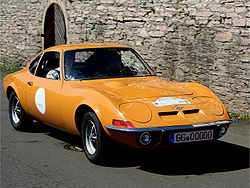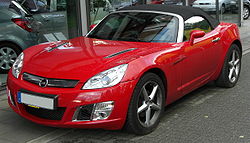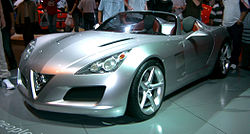- Opel GT
-
Opel GT 
Manufacturer Opel Production 1968–1973 Assembly Rüsselsheim, Germany Successor Opel Manta Body style 2-door coupe Layout FR layout Engine 1,078 cc (65.8 cu in) I4
1,897 cc (115.8 cu in) I4Transmission 4-speed manual
3-speed automaticWheelbase 2,415 mm (95.1 in) Length 4,113 mm (161.9 in) Width 1,580 mm (62.2 in) Height 1,225 mm (48.2 in) Curb weight 845 kg (1,863 lb)–940 kg (2,072 lb) The Opel GT is a two-seat sports car first presented as a styling exercise in 1965 at the Paris and Frankfurt motor shows, and introduced as a production model late in 1968[1] by Opel, a German subsidiary of General Motors. It relied partly on components from the contemporary Opel Kadett B and had a body made by French contractor Brissonneau & Lotz.
Its styling has been likened to the 1968 Chevrolet Corvette which went on sale in September 1967.[2]
Although the life of the GT was limited to six model years, after a 34-year hiatus it returned as a 2007 model based on the Saturn Sky, and was built alongside it in Wilmington, Delaware, USA. The plant was scheduled to close in July 2009, ending production of the GT, and its siblings.
Contents
General information
The Opel GT was equipped with a base 1.1 L OHV straight-4 engine, which produced 67 hp (SAE) at 6000 rpm. However, most buyers chose an optional 1.9 L Cam-In-Head (CIH) engine, which produced 102 hp (SAE) at 5200 to 5400 rpm. Some of the early 1968 models also came with a slightly higher compression "H" code cylinder head. In 1971, due to emissions regulations, Opel reduced the compression ratio of the U.S.1.9 L engine and output fell to 83 hp (SAE). There was also a GT/J model, which was a less expensive version of the 1900GT sold only in Europe. Standard transmission was a manual 4-speed. A three-speed automatic was available with the 1.9 L engine. The model run of the Opel GT was from 1968 to 1973.
The Opel GT used a steel unibody and a conventional front-engined, rear-wheel drive layout. The Cam-In-Head (CIH) engine was mounted far back in the chassis to improve weight distribution. Front suspension consisted of upper A-arms and a lower transverse leaf spring. A live axle and coil springs were used in the rear. The power-assisted braking system used discs in the front, drums in the rear. Steering was unassisted.
One unusual feature of the Opel GT was the operation of the pop-up headlights. They were manually operated, by way of a large lever along the center console next to the shifter. Unlike most pop-up headlights, they both rotated in the same direction (counterclockwise from inside the car) about a longitudinal axis. One standard joke about GT owners was that you can easily spot them due to the heavy muscles on their right arm built up by using the lever to pop up the headlights.
Designed by GM Stylist Clare MacKichan, the Opel GT was a fastback, that had neither an externally accessible trunk nor a conventional hatchback. There was a parcel shelf behind the seats that could only be accessed through the main doors. Behind the parcel shelf was a fold-up panel that concealed a spare tire and jack.
The interior of the Opel GT was surprisingly large for a car its size, owing to its original design process (exterior metal was sculpted around an interior model). Headroom and legroom were sufficient for those over 6 feet (1.83 m) tall.
During 1968 to 1973, a total of 103,463 cars were sold. The most collectable GTs are probably the first few hundred cars hand-assembled in 1968 and the 1968–1969 models with the 1.1 L engine, which totaled out at 3,573 cars. Of the later cars 10,760 were the cheaper model (GT/J), which lacked nearly all chrome parts and less standard features. In some markets, items like a limited slip differential, front and rear anti-sway bars, heated rear window and engine bay light were standard, although most cars were shipped without them.
In North America, the GT was sold at Buick dealerships. Reasons for ending production were the need to redesign the car to remain competitive with up-and-coming sports models, such as the Datsun 240Z, as well as the termination of Brissonneau and Lotz' bodybuilding contract.
Appearances in media
A gold 1969 Opel GT was Agent Maxwell Smart's car in the last season of the comedy TV series Get Smart. Agent 86 (Maxwell Smart) drove a GT in several episodes, with the car featuring prominently in the opening credits. In the 2008 movie adaptation Get Smart, Bernie Kopell (who played Siegfried in the original Get Smart series) makes a cameo appearance in which he drives a GT. This is a reference to the original cars of Get Smart, as the Sunbeam Tiger and the VW Karmann Ghia (Maxwell Smart's cars in Season 1-2 and 3-4, respectively) are in the scene with the GT.
Automotive Magazine "Road & Track" reviewed the GT in their June 1969 issue, recording 0–96 km/h in 10.8 seconds and a top speed of 182 km/h. Road & Track also found the car to have strong understeer, suggesting the 165x13 tires to be too small, although the ride was comfortable.
Classic GTs today
The Opel GT shared many parts with other Opel models, mostly the Kadett B. Opel also used variants of the CIH engine from 1966 to 1995, so most parts are somewhat available. Also, in the USA and Europe, there are companies which specialize in Opel GT parts and services; including some new body parts. Some of the rarest and most costly parts are the ignition switches, rear trim strips, and 1968–1970 rear axle bearings.
One can fairly easily adapt larger engines, transmissions and brakes from newer Opels. For example, a fuel-injected 2.0 L engine (110 hp DIN) and a 5-speed Getrag manual transmission from an Rekord E or Manta B may be used to improve both fuel economy and performance.
Modern Opel GT
Opel GT Manufacturer General Motors Corporation Also called Saturn Sky
Daewoo G2XProduction 2006–2009 Assembly Wilmington, Delaware, USA Predecessor Opel Speedster Body style roadster Layout FR layout Engine 1998 cc I4 Wheelbase 2,415 mm (95.1 in) Length 4,091 mm (161.1 in) Width 1,813 mm (71.4 in) Height 1,276 mm (50.2 in) Curb weight 1,325 kg (2,921 lb)–1,406 kg (3,100 lb) Related Pontiac Solstice Main article: Saturn SkyOn February 1, 2006, Opel issued a press release announcing the upcoming production of a new Opel GT, as a likely 2007 model. The car shares the GM Kappa platform with the Pontiac Solstice and the Saturn Sky. Unlike its platform mates, the 2.0 L, 260 hp (194 kW; 264 PS) direct injection turbocharged Ecotec four-cylinder engine is the only engine being offered. It also features 18-inch alloy wheels and a folding cloth top similar to those found on the Solstice and the Sky. Since GM's Saturn division already shares models with Opel, the GT is in fact Opel's version of the Saturn Sky. The car replaced the Opel Speedster in the European lineup; however, it was not sold in right-hand drive in the UK, thus there is no replacement for the Vauxhall VX220. The situation is similar to Holden in Australia, as the Saturn Sky and Pontiac Solstice are produced at a North American plant, which does not have the necessary tooling for producing right-hand drive vehicles.
Model Year Total Modern Opel GT Production[3] 2007 2,365 2008 4,851 2009 301 2010 2 Total 7,519 References
- ^ "Opel GT Corvette for Europe?". Autocar 129 (nbr 3790): page 55. date 3 October 1968.
- ^ Opel GT at Howstuffworks.com
- ^ "General Motors: Investors: Sales and Production Reports: Historical Production". GM. 2009-07-10. http://www.gm.com/corporate/investor_information/sales_prod/hist_prod.jsp. Retrieved 2009-11-01.
- Henrion/Müller (1997). Opel GT Projekt 1484. Podszun. ISBN 3-86133-170-5.
- road test article compilation (?). Opel GT Gold Portfolio 1968–1973. Brooklands Books. ISBN 1-85520-326-X.
External links
- www.opelgtworld.de
- Opel Motorsport Club
- The Classic Opel Community
- VisualOpel - Illustrations, diagrams, and parts
- Forum for the 2007-2009 Opel GT
- Classic Opel Parts database
« previous — Opel road car timeline, 1980s–present Type 1980s 1990s 2000s 2010s 0 1 2 3 4 5 6 7 8 9 0 1 2 3 4 5 6 7 8 9 0 1 2 3 4 5 6 7 8 9 0 City car Agila A Agila B Supermini Corsa A Corsa B Corsa C Corsa D Compact car Kadett C Kadett D Kadett E Astra F Astra G Astra H Astra J Large family car Ascona B Ascona C Vectra A Vectra B Vectra C Insignia Signum Executive car Rekord E/ Commodore C Omega A Omega B Luxury car Senator A/ Monza Senator B Sports car Tigra Tigra TwinTop Manta B Calibra Speedster GT Mini MPV Meriva A Meriva B Compact MPV Zafira A Zafira B Large MPV Sintra SUV Frontera A Frontera B Antara Monterey LCVs Combo B Combo C Arena Vivaro Movano Movano Opel road car timeline, 1947–1970s next » Type 1940s 1950s 1960s 1970s 7 8 9 0 1 2 3 4 5 6 7 8 9 0 1 2 3 4 5 6 7 8 9 0 1 2 3 4 5 6 7 8 9 Small family car Kadett A Kadett B Kadett C Olympia Olympia Rekord Olympia A Large family car Rekord PI Rekord PII Ascona A Ascona B Executive car Rekord A Rekord B Rekord C Rekord D Rekord E Kapitän Kapitän Kapitän PI / PII Commodore A Commodore B Commodore C Luxury car Kapitän A / Admiral A / Diplomat A Kapitän B / Admiral B / Diplomat B Senator / Monza Coupé / Roadster GT Manta A Manta B Opel Current Opel
passenger carsCurrent Opel
commercial vehiclesHistoric and
discontinued modelsAdmiral • Arena • Ascona • Bedford Blitz • Blitz • Calibra • Campo • Chevette • Commodore • Diplomat • 5/12 PS "Puppchen" • 4/8 PS "Doktorwagen" • Frontera • GT • Kadett • Kapitän • Laubfrosch • Manta • Monterey • Monza • Olympia • Omega • Patentmotorwagen „System Lutzmann“ • P4 • RAK • RAK1 • RAK2 • Regent • Rekord • Senator • Signum • Sintra • Speedster • Super 6 • Tigra • 10/30 (10/35) PS • 12,3-Liter-Rennwagen • VectraMotor racing cars Concept cars Divisions and
subsidiariesOpel Eisenach GmbH • Opel Motoren Kaiserslautern GmbH • Opel Powertrain GmbH • Opel Performance Center GmbH • Opel Special Vehicles GmbHOther Founder: Adam Opel • Opel InternationalCategories:- Opel vehicles
- Rear wheel drive vehicles
- Sports cars
- Coupes
- Roadsters
- 1960s automobiles
- 1970s automobiles
- 2000s automobiles
- Vehicles introduced in 1968
- Vehicles introduced in 2006
Wikimedia Foundation. 2010.


